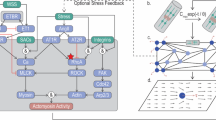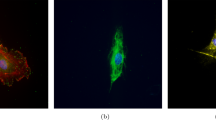Abstract
Finite element (FE) simulations of contractile responses of vascular muscular thin films (vMTFs) and endothelial cells resting on an array of microposts under stimulation of soluble factors were conducted in comparison with experimental measurements reported in the literature. Two types of constitutive models were employed in the simulations, i.e. smooth muscle cell type and non-smooth muscle cell type. The time histories of the effects of soluble factors were obtained via calibration against experimental measurements of contractile responses of tissues or cells. The numerical results for vMTFs with micropatterned tissues suggest that the radius of curvature of vMTFs under stimulation of soluble factors is sensitive to width of the micropatterned tissue, i.e. the radius of curvature increases as the tissue width decreases. However, as the tissue response is essentially isometric, the time history of the maximum principal stress of the micropatterned tissues is not sensitive to tissue width. Good agreement has been achieved for predictions of the vasoconstrictor endothelin-1-induced contraction stress between the FE numerical simulation and the experiment-based approach of Alford (Integr Biol 3:1063–1070, 2011) for the vMTFs with 40, 60, 80 and 100 \(\upmu \hbox {m}\) width patterns. This may suggest the contraction stress is weakly sensitive to the tissue width for these patterns. However, for 20 \(\upmu \hbox {m}\) width tissue patterning, the numerical simulation result for contraction stress is less than the average value of experimental measurements, which may suggest the thinner and more elongated spindle-like cells within the 20 \(\upmu \hbox {m}\) width tissue patterning have higher contractile output. The constitutive model for non-smooth muscle cells was used to simulate the contractile response of the endothelial cells. The substrate was treated as an effective continuum. For agonists such as lysophosphatidic acid and vascular endothelial growth factor, the deformation of the cell diminishes from edge to centre and the central part of the cell is essentially under isometric state. Numerical studies demonstrated the scenarios that cell polarity can be triggered via manipulation of the effective stiffness and Possion’s ratio of the substrate.









Similar content being viewed by others
References
Alford PW, Nesmith AP, Seywerd JN, Grosberg A, Parker KK (2010) Biohybrid thin films for measuring contractility in engineered cardiovascular muscle. Biomaterials 31:3613–3621
Alford PW, Nesmith AP, Seywerd JN, Grosberg A, Parker KK (2011) Vascular smooth muscle contractility depends on cell shape. Integr Biol 3:1063–1070
Barany M (1967) ATPase activity of mysion correlated with speed of muscle shortening. J Gen Physiol 50:197–218
Breckenridge MT, Desai RA, Yang MT, Fu J, Chen CS (2014) Substrates with engineered step changes in rigidity induce traction force polarity and durotaxis. Cell Mol Bioeng 7:26–34
Dembo M (1994) On peeling an adherent cell from a surface. In: Vol. 24 of series: lectures on mathematical problem in Biology. American Mathematical Society, Providence, RI, pp 51–77
Deshpande VS, McMeeking RM, Evans AG (2006) A bio-chemo-mechanical model for cell contractility. Proc Natl Acad Sci USA 103:015–020
Deshpande VS, McMeeking RM, Evans AG (2007) A model for the contractility of the cytoskeleton including the effect of the stress fibre formulation and dissociation. Proc R Soc Lond A 463:787–815
Emori T, Hirata Y, Ohta K, Kanno K, Eguchi S, Imai T, Shichiri M, Marumo F (1991) Cellular mechanism of endothelin-1 release by angiotensin and vasopressin. Hypertension 18(2):165–170
Hai CM, Murphy RA (1988a) Cross-bridge phosphorylation and regulation of latch state in smooth muscle. J Appl Physiol 254:C99–C106
Hai CM, Murphy RA (1988b) Regulation of shortening velocity by cross-bridge phosphorylation in smooth muscle. Am J Physiol 255:C86–C94
Hill AV (1938) The heat of shortening and the dynamic constraints of muscle. Proc R Soc Lond B 126:136–195
Jackson WF (2000) Ion channels and vascular tone. Hypertension 35:173–178
Katoh K, Kano Y, Noda Y (2011) Rho-associated kinase-dependent contraction of stress fibres and the organization of focal adhesions. J R Soc Interface 8(56):305–311
Liu T (2014) A constitutive model for cytoskeletal contractility of smooth muscle cells. Proc R Soc Lond A 470:2164
Loosli Y, Luginbuehl R, Snedeker JG (2010) Cytoskeleton reorganization of spreading cells on micro-patterned islands: a functional model. Philos Trans R Soc Lond A 368(1920):2629–2652
McGarry P, Chen CS, Deshpande VS, McMeeking RM, Evans AG (2009) Simulation of the contractile response of cells on an array of micro-posts. Philos Trans R Soc A 367:3477–3497
Murphy RA (1988) Muscle cells of hollow organs. News Physiol Sci 3:124–128
Obbink-Huizer C, Foolen J, Oomens CWJ, Borochin M, Chen CS, Bouten CVC, Baaijens FP (2014) Computational and experimental investigation of local stress fibre orientation in uniaxially and biaxially constrained microtissues. Biomech Model Mechanobiol 13:1053–1063
Pathak A, Deshpande VS, McMeeking RM, Evans AG (2008) The simulation of stress fibre and focal adhesion development in cells on patterned substrates. J R Soc Interface 5:507–524
Shim J, Grosberg A, Nawroth JC, Parker KK, Bertoldi K (2012) Modeling of cardiac muscle thin films: pre-stretch, passive and active behaviour. J Biomech 45:832–841
Shukla A, Dunn AR, Moses MA, Vliet KJV (2004) Endothelial cells as mechanical transducers: enzymatic activity and network formation under cyclic strain. Mech Chem Biosyst 1:279–290
Tan JL, Tien J, Pirone DM, Gray DS, Bhadriraju K, Chen CS (2003) Cells lying on a bed of microneedles: an approach to isolate mechanical force. Proc Natl Acad Sci USA 100:1484–1489
Yang MT, Reich DH, Chen CS (2011) Measurement and analysis of traction force dynamics in response to vasoactive agonists. Integr Biol 3:663–674
Zhang W, Soman P, Meggs K, Qu X, Chen S (2013) Tuning the Poisson’s ratio of biomaterials for investigating cellular response. Adv Funct Mater 23:3226–3232
Acknowledgements
The author is grateful for access to the University of Nottingham High Performance computing facility. The work reported in the paper is supported by Tsinghua/Nottingham Research and Teaching Fund. The constructive comments from the anonymous referee are gratefully acknowledged.
Author information
Authors and Affiliations
Corresponding author
Electronic supplementary material
Below is the link to the electronic supplementary material.
Rights and permissions
About this article
Cite this article
Liu, T. Simulation of cell-substrate traction force dynamics in response to soluble factors. Biomech Model Mechanobiol 16, 1255–1268 (2017). https://doi.org/10.1007/s10237-017-0886-6
Received:
Accepted:
Published:
Issue Date:
DOI: https://doi.org/10.1007/s10237-017-0886-6




